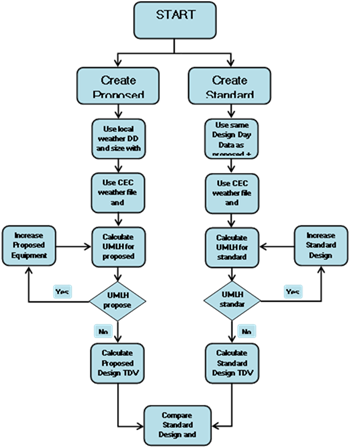

The general calculation procedure is illustrated in Figure 2. The proposed design TDV energy use is compared to the standard design.

1. The process begins with a detailed description of the proposed design. Information is provided in enough detail to enable an estimate of annual energy use for a typical weather year. This information includes the building envelope, the lighting systems, the HVAC systems, the water heating systems and other important energy-using systems. This collection of information is referred to in this 'manual as building descriptors. Details on the building descriptors are provided in Chapter 5.
2. Before the calculations are performed, some of the building descriptors are modified for the proposed design to incorporate prescribed modeling assumptions. Prescribed modeling assumptions include occupant density, equipment power density, ventilation rates and water heating loads.
3. The next step is to make a simulation of the proposed design to determine how well the heating and cooling loads are being satisfied. The indicator is unmet load hours, the number of occupied hours during the year when the space temperature in one or more zones is below the heating set point temperature or greater than the cooling set point temperature. A large number of hours indicates that the equipment is undersized.
4. Test the number of unmet load hours and proceed only if the hours for each zone in the building are less than or equal to 150 for the year of the proposed design simulation.
5. If the unmet load hours are greater than 150 for the year, then the proposed building simulation model is adjusted by the user to reduce the unmet load hours to less than or equal to 150. No zone may exceed 150 unmet load hours. If the problem is heating, then the size of the boiler or furnace may need to be increased. If the problem is cooling, then the size of the coils or chillers may need to be increased. It is up to the designer to adjust equipment sizes as necessary; in some cases adjusting the zone airflows may solve the unmet load issue.
6. If the unmet load hours are less than or equal to 150, then the final simulation is performed. If no changes are made in the model, this may be the same simulation in step 3. These calculations produce the results that are compared to the standard design, which is calculated in steps 7 through 16.
7. Create the standard design following the rules in this 'manual. The standard design has the same floor area, number of floors and spatial configuration as the proposed design; however, systems and components are modified to be in minimum compliance with the standard design. The HVAC systems for the standard design are established according to rules in this 'manual and depend on the primary building activity (residential or non-residential), the floor area, and the number of stories. See Section 5.1.
8. Sizing calculations are performed for the standard design and heating equipment is oversized by 25% and cooling equipment by 15%.
9. The standard design is simulated to determine the number of unmet load hours. This process is the same as performed for the proposed design in step 3.
10. The number of unmet load hours for the standard design is then tested to see if they are greater than 150 for any zone(s). This is not likely to occur since the heating and cooling equipment is oversized by 15% for cooling and 25% for heating in step 8.
11. If the unmet load hours are greater than 150, then equipment capacity in the standard design is increased so that the unmet hours are less than or equal to 150. See the discussion below on how equipment sizes are increased.
12. Once the tests on unmet load hours are satisfied, then the energy consumption of the standard design is calculated. If the tests on unmet hours are satisfied the first time through, this step is the same as step 9.
13. Finally, the proposed design TDV energy use and standard design TDV energy use are compared for compliance or Reach.